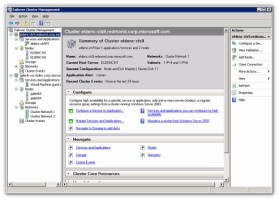REDMOND, Wash., June 19, 2008 – Of all the responsibilities borne by IT departments, ensuring the availability of mission-critical applications, services, and data is arguably both the most important and the most challenging. One technology that helps IT organizations meet uptime requirements for their essential systems is failover clustering (FC), in which servers are linked together so if one node fails, another in its cluster can pick up its functions.

Bob Visse, senior director in the Windows Server Marketing Group, Microsoft.
Until recently, the implementation of failover clustering has been a kind of “dark art” that required a high degree of IT expertise to implement. So although the concept of clustering has been around for decades, until now it has been practical only for organizations that had extensive IT resources to administer and manage.
Microsoft has changed that picture in two important ways:
-
The simplified failover clustering management capability of Microsoft’s recently released Windows Server 2008 operating system makes FC practical and easy to implement for a wider set of customers, including organizations with fewer than 250 computers.
-
By establishing the Failover Clustering Configuration Program (FCCP), under which Microsoft partners with key cluster vendors to ensure that pre-configured cluster configurations are strenuously tested for efficacy and ease of installation.
Clustering for the Masses
With Windows Server 2008, businesses of all sizes can ensure business continuity by implementing failover clustering for critical line-of-business services, applications and servers, reducing both unplanned and planned downtime. It even supports geographically dispersed clusters, which is critical for multi-site business continuity.
“Windows Sever 2008 makes clustering simple to set up, deploy, and manage,” says Bob Visse, a senior director in the Windows Server Marketing Group at Microsoft. “It features enhancements that simplify the entire clustering workflow—increasing cluster security, providing enhanced stability and facilitating easier setup and management.”

The Windows Server 2008 Failover Clustering MMC (Microsoft Management Console) user interface.
Failover clustering improvements in Windows Server 2008 include:
-
A built-in validation toolset and configuration validation Wizard
-
Improved cluster setup and migration
-
Simplified management interfaces
-
Support for multi-site clustering
-
An enhanced quorum model
-
Improved support for storage area networks (SANs), and
-
Improved stability and security, resulting in increased availability.
”By reducing the learning curve associated with the setup, deployment, and maintenance of Windows Server clusters, Microsoft’s new approach to optimizing and automating the deployment of high availability (HA) clustering software — as embodied in Windows Server Failover Clustering — can be expected to reduce operational expenses for customers who are leveraging HA software to protect Windows business applications on both physical and virtual servers,” wrote IDC analyst Jean Bozman in her April 2008 report, “Microsoft Automates Cluster Services in Windows Server 2008 Failover Clustering” (IDC report 211794).
Ward Ralston, group product manager for Windows Server, explained how the product addressed the needs of IT professionals: “We went through the records of calls to our Customer Support Services hotline for the past several years relating to problems setting up clusters. We discovered that more than 55 percent of misconfigured clusters were the result of IT pro error. So we created a cluster configuration validation wizard for Windows Server 2008 that tests all the nodes in a network for proper configuration before they can be set up as a server cluster.
Simplified Hardware Selection
“One of the other aspects of failover clustering that can be daunting, especially for organizations that are creating their first clustering solution, is the selection of hardware such as the shared storage and networking equipment that is used between the nodes and the clusters,” says Ralston. “That’s why we instituted the FCCP — so you can eliminate that last level of complexity by ordering a pre-configured and tested clustering configuration from one of our partners.”
Under the FCCP, Microsoft is partnering with vendors to ensure that systems designed to support failover clustering are tested, validated and easy to implement. To be part of the program, manufacturers must put their products through strenuous testing.
In the past, individual components that were approved for clustering under the Windows Server 2003 platform were recorded on a Cluster Hardware Compatibility List (HCL). With the advent of Windows Server 2008, the Cluster HCL is being discontinued in favor of this validation program for entire configurations. Complete configurations might include servers, interconnects, storage adapters and controllers, firmware and drivers.
Among the vendors participating in the FCCP are orignial equipment manufacturer Dell and storage vendors NetApp and EMC.
“Businesses today require information and resources to be available as reliably and securely as possible,” said Judy Chavis, director of marketing and business development at Dell. “Our strong partnership with Microsoft, coupled with Dell’s existing methodology of providing support for customers with fully tested and validated high-availability clusters, ensures that our customers’ mission-critical applications, data and services are always available and capable of scaling to meet their growing needs.”
“This program enables our mutual customers to deploy highly-available Windows server configurations, and lets them easily locate, select and receive support for NetApp-tested Windows Server 2008 Failover Clustering configurations,” said Patrick Rogers, vice president of solutions marketing for NetApp.
“EMC is dedicated to providing customers with integrated, reliable and easy-to-deploy solutions that enable IT organizations to quickly respond to changing business demands,” said Paul Brown, vice president of integration and interoperability at EMC’s E-Lab. “Joint customers can be confident that EMC solutions for Microsoft Windows Server 2008 Failover Clustering have been rigorously tested in the EMC E-Lab to deliver the high availability that is required in today’s Windows Cluster deployments.”
For the first time, any customer can achieve mission-critical business continuity, regardless of its size. The Hillsboro, Ore. school district is one example of this new type of high availability customer.
“We depend heavily on Microsoft Windows Server 2008 Failover Clustering technology to maintain our systems’ resiliency,” said John Goucher, senior network engineer for the Hillsboro School District. “The enhancements deliver higher availability and reduce our administrative overhead. In addition, with hardware requirements to build a cluster being complex, the new Failover Cluster Validation Program will help to ensure we are purchasing systems we know are fully supported by the hardware vendor.”




